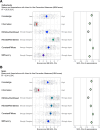Determinants of intended prevention behaviour against mosquitoes and mosquito-borne viruses in the Netherlands and Spain using the MosquitoWise survey: cross-sectional study
- PMID: 38965485
- PMCID: PMC11223381
- DOI: 10.1186/s12889-024-19293-0
Determinants of intended prevention behaviour against mosquitoes and mosquito-borne viruses in the Netherlands and Spain using the MosquitoWise survey: cross-sectional study
Abstract
Background: Recently, Europe has seen an emergence of mosquito-borne viruses (MBVs). Understanding citizens' perceptions of and behaviours towards mosquitoes and MBVs is crucial to reduce disease risk. We investigated and compared perceptions, knowledge, and determinants of citizens' behavioural intentions related to mosquitoes and MBVs in the Netherlands and Spain, to help improve public health interventions.
Methods: Using the validated MosquitoWise survey, data was collected through participant panels in Spain (N = 475) and the Netherlands (N = 438). Health Belief Model scores measuring behavioural intent, knowledge, and information scores were calculated. Confidence Interval-Based Estimation of Relevance was used, together with potential for change indexes, to identify promising determinants for improving prevention measure use.
Results: Spanish participants' responses showed slightly higher intent to use prevention measures compared to those of Dutch participants (29.1 and 28.2, respectively, p 0.03). Most participants in Spain (92.2%) and the Netherlands (91.8%) indicated they used at least one prevention measure, but differences were observed in which types they used. More Spanish participants indicated to have received information on mosquitoes and MBVs compared to Dutch participants. Spanish participants preferred health professional information sources, while Dutch participants favoured government websites. Determinants for intent to use prevention measures included "Knowledge", "Reminders to Use Prevention Measures", and "Information" in the Netherlands and Spain. Determinants for repellent use included "Perceived Benefits" and "Cues to Action", with "Perceived Benefits" having a high potential for behavioural change in both countries. "Self-Efficacy" and "Knowledge" were determinants in both countries for breeding site removal.
Conclusion: This study found differences in knowledge between the Netherlands and Spain but similarities in determinants for intent to use prevention measures, intent to use repellents and intent to remove mosquito breeding sites. Identified determinants can be the focus for future public health interventions to reduce MBV risks.
Keywords: Confidence Interval Based Estimation of Relevance Analysis; Health Belief Model; Knowledge; Mosquito-borne viruses; Prevention and control; Social Determinants of Health; Surveys and Questionnaires; Vector-Borne Diseases.
© 2024. The Author(s).
Conflict of interest statement
The authors declare no competing interests.
Figures



References
-
- Vlaskamp DRM, Thijsen SFT, Reimerink J, Hilkens P, Bouvy WH, Bantjes SE, Vlaminckx BJM, Zaaijer H, van den Kerkhof HHTC, Raven SFH. First autochthonous human West Nile virus infections in the Netherlands, July to August 2020. Eurosurveillance. 2020;25(46):2001904. doi: 10.2807/1560-7917.ES.2020.25.46.2001904. - DOI - PMC - PubMed
-
- Dengue worldwide overview. https://www.ecdc.europa.eu/en/dengue-monthly.
Publication types
MeSH terms
LinkOut - more resources
Full Text Sources

